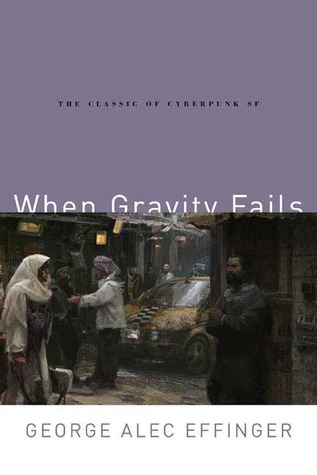***** The series that
made me revalue cyberpunk
Cyberpunk is a genre with which I have never had great affinity. My
previous attempts to read it (“Virtual Light” by Gibson and “Feersum Endjinn”
by Banks) failed in impressing me, though, ironically, I have ventured into
writing (also) this sub-genre of science fiction. In short, I suspected that
the problem wasn’t the sub-genre in itself, but that I had come across the
wrong titles, at least for what concerned my personal tastes. In fact, I have
always had a lot of fun in reading more recent books in which the cyberpunk
element was important but not dominant (as the Void Trilogy by Hamilton).
Luckily, when I started reading Effinger’s books I had no idea of being
in front of one of the fathers of cyberpunk in its period of greatest
development, the 80s. This shows how the labels sometimes do more harm than
good. I had only two books of the series, which I got at different times,
without even knowing that they were connected. As soon as I started reading the
first, and I was captured by it, I immediately strove to find a copy of the
third, because I knew I would’ve needed it very soon.
Having read all of them in a row, I decided to review them together,
because it’s hard to judge them separately without being influenced by previous
or subsequent readings.
The Budayeen trilogy (it would be more correct to call it a series,
since the author had planned at least two more books, which unfortunately he
had no time to write before his death) is not only cyberpunk. The story is set
in two centuries, in a rough neighbourhood, the Budayeen, in an unspecified
city in the Arab world. In the future imagined by Effinger people get their
brain “circuited” to be able to insert some modules that provide the individual
with new knowledge, skills, and even personalities. The cyberpunk element is
provided by this technology, which is in fact one of the few science fiction
elements in the story. Here science fiction is just a tool to tell the story of
the characters and especially for much of the first book (but also for large
parts of the others) the same story would work just as well if told in a
context outside of speculation fiction.
Regarding now, thirty years later, this imaginary future, it appears
full of anachronistic elements, like an alternate universe or just a universe
outside of time.
The Budayeen is actually a metaphor for the French Quarter of New
Orleans (Effinger had never hidden that), with its nightclub, where it seems it’s
quite difficult to find a woman who is genetically such, and with its organised
crime. Added to this is the exotic touch of having inserted it in the Islamic
world, which is represented accurately with all its contradictions, even more
evident when imagined in two hundred years. The relationship of the characters
with the Islamic religion, the respect towards it, accompanied with the most illegal
actions is a smart reference to the contradictory but sadly real
Catholicism-mafia binomial, which cannot help but make you smile. It’s a little
like saying that in the future, while changing the people, places and even
religion, the results you get are always the same.
Beyond this setting, the novels by Effinger all revolve around the
figure of the protagonist, Marîd Audran, a private detective, who is a drug
addict, a cautious (not to say cowardly), flawed, but very human character,
trying to make ends meet by doing more or less legal chores, between a hangover
and the other, supported by various kinds of pills (depending on the occasions:
for sleeping, against anxiety, for staying awake, and so on), and risking to be
killed at any moment. In all this Marîd, who tells his story in first person,
never loses his self-deprecating humour, even in the worst situations. In
short, he is a likeable rogue, indeed a very nice antihero.
I laughed so much in reading these novels, but
what makes them so good is their unpredictability. Effinger doesn’t follow
patterns. The story is realistic thanks to the way in which events happen
almost randomly, just like in real life, without logic. You never know what
will happen in the next page and you cannot help but keep reading. So every day
I found myself waiting with trepidation for the time when I would go to bed and
pick up the book.
Marîd slips into a mess after another. When you
think it couldn’t become worse than that, well, it becomes worse. But for
better or worse he pulls himself out, meaning that he survives.
In the first book he investigates some murders,
tries to prop up his affair with the beautiful dancer Yasmin (of which he is
very much in love), who hasn’t always been a woman, tries to avoid ending up
under the control of Friedlander Bey, the “mafia boss” of the Budayeen, and of
course not to get killed.
In the second one he finds out about an obscure
program, called Phoenix, because of which many people are killed, and finds himself working
with the police.
In the third one he ends up in exile in the Arabian Desert, where he
lives for a while with the nomads. This book seems almost split in two, with
one part set in the desert and another in the Budayeen that are completely
separate.
Effinger was a great author and this is proved
by the skill with which he used the various narrative techniques.
One thing I particularly liked is the narrative
device which shows us the scenes where Marîd is wearing a personality module
(called moddy). Suddenly it goes from first to third person,
creating a distance between the reader and the character that simulates the
feeling that the latter must have while the control of himself is filtered by a
software, while his consciousness is almost put aside, as if he were a
spectator. In reading these scenes you really have the impression of living in
a kind of altered state, a bit as it happens to Marîd himself. Especially fun
is when the protagonist tries a moddy of Nero Wolf and feels more fat and
totally uninterested in women.
The same trick is used in the two scenes set in
virtual reality (in the second book), while Marîd and Chirinda are playing a
game. The scenes do not make the plot advance, but Effinger wrote them anyway
and they are still very enjoyable just because of the feeling of “filtered
participation” they give and that distinguishes them from the rest of the
novel.
Another aspect that I appreciated is the
tendency of the author to show Marîd at some point in the story and then make
him put the pieces together, often overshadowed by his memories, of what
happened before, with a transition to a flashback that
imitates the way with which memory works. Marîd goes back in thoughts and
shows us everything that happened, even for many pages, up to the point of
apparent tranquillity from which the chapter has started. So little by little
we finds out that he is in a big trouble from which it is impossible to imagine
how he will manage to come out. Often this realisation is followed by a plot
twist that worsens even more things for him, if possible.
Due to the absence of patterns and for the thin
vein of imperfection that crosses all the books, each of them is characterized
by a melancholic or bittersweet ending, but which is always open. And, given
that Effinger died before writing the books that followed, these endings
entitle us to imagine what happens next.
In this regard, I would add that there is a
posthumous collection of short stories, “Budayeen Nights” (I’ll review it
separately), which includes a series of writings by Effinger including the
beginning of the fourth book, and above all a story starring Marîd (although
his name is never pronounced) that allows us to take a look at his future where
apparently he has freed himself from the control of the “mafia boss” of the
Budayeen and has a fairly quiet life, even if sometimes he gets involved in
dangerous investigations.
The three novels in the Budayeen trilogy are: “When
Gravity Fails”, “A Fire in the Sun”, and “The Exile Kiss”.
If you have the opportunity to get them, don’t
miss it.
When Gravity Fails, A Fire in the Sun e The Exile Kiss on Amazon.




No comments:
Post a Comment